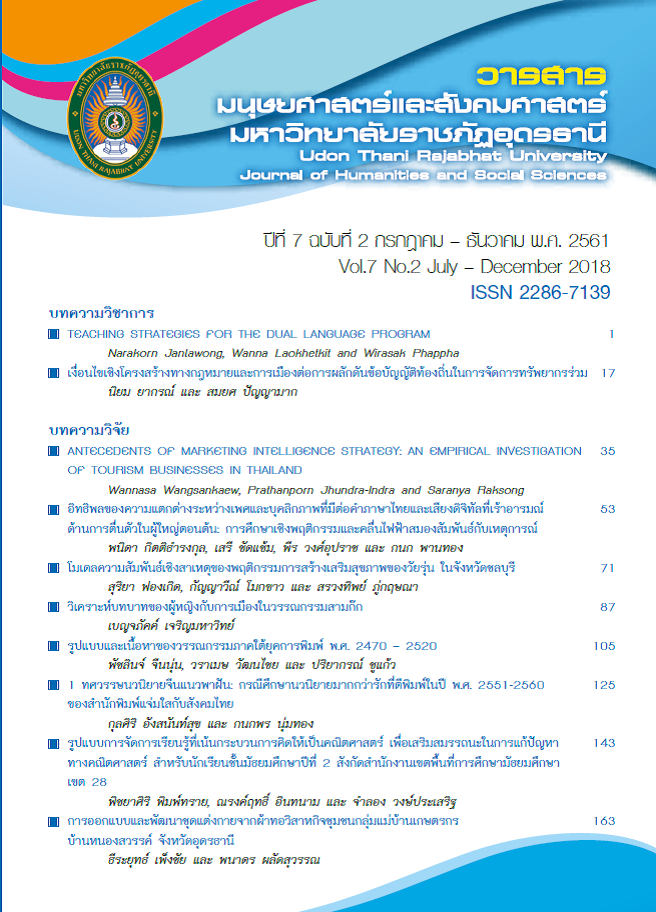อิทธิพลของความแตกต่างระหว่างเพศและบุคลิกภาพที่มีต่อคำภาษาไทย และเสียงดิจิทัลที่เร้าอารมณ์ด้านการตื่นตัวในผู้ใหญ่ตอนต้น: การศึกษาเชิงพฤติกรรมและคลื่นไฟฟ้าสมองสัมพันธ์กับเหตุการณ์
Main Article Content
บทคัดย่อ
การศึกษาวิจัยนี้มีวัตถุประสงค์ เพื่อศึกษาอารมณ์ด้านการตื่นตัวและคลื่นไฟฟ้าสมองสัมพันธ์กับเหตุการณ์ขณะทำกิจกรรมการทดลองของผู้ใหญ่ตอนต้น เปรียบเทียบระหว่างเพศกับบุคลิกภาพ กลุ่มตัวอย่างมีอายุระหว่าง 20-24 ปี จำนวน 80 คน ใช้แบบแผนการทดลอง 2 x 2 Factorial Posttest Design เครื่องมือที่ใช้ในการทดลองประกอบด้วยกิจกรรมทดลองการมองคำภาษาไทยและฟังเสียงดิจิทัลที่เร้าอารมณ์ความรู้สึกด้านการตื่นตัว เครื่องบันทึกคลื่นไฟฟ้าสมอง Neuroscan และโปรแกรม Curry Neuroimaging Suit 7.0 และหมวกอิเล็กโทรดที่มีขั้วไฟฟ้า 64 Channels และมาตรวัดอารมณ์ความรู้สึก Self-Assessment Manikin Thai Version (SAM) ด้านการตื่นตัว วิเคราะห์ข้อมูลด้วยสถิติ two-way ANOVA ผลการวิจัยพบว่า
อารมณ์ด้านการตื่นตัวของผู้ใหญ่ตอนต้นมีความแตกต่างกันระหว่างบุคลิกภาพ และมีปฏิสัมพันธ์ระหว่างเพศกับบุคลิกภาพ ขณะมองคำภาษาไทยและฟังเสียงดิจิทัลที่เร้าอารมณ์ด้านการตื่นตัว ลักษณะตื่นเต้น อย่างมีนัยสำคัญทางสถิติที่ระดับ .05
เกิดคลื่นไฟฟ้าสมองสัมพันธ์กับเหตุการณ์ขณะมองคำภาษาไทยและฟังเสียงดิจิทัลที่เร้าอารมณ์ด้านการตื่นตัว ที่ช่วง P100, N100 และ P200 โดยคลื่นไฟฟ้าสมองระหว่างเพศชายกับเพศหญิง ขณะทดลองอารมณ์ด้านการตื่นตัว ลักษณะสงบ แตกต่างกันที่ช่วง N100 ลักษณะเฉย ๆ แตกต่างกันที่ช่วง P100 ช่วง N100 และช่วง P200 และลักษณะตื่นเต้น แตกต่างกันที่ช่วง P100 ช่วง N100 และช่วง P200 ส่วนคลื่นไฟฟ้าสมองระหว่างบุคลิกภาพแบบเปิดเผยกับแบบกลาง ๆ ขณะทดลองอารมณ์ด้านการตื่นตัว ลักษณะสงบ แตกต่างกันที่ช่วง P100 และ N100 ลักษณะเฉย ๆ แตกต่างกันที่ช่วง P100 และลักษณะตื่นเต้น แตกต่างกันที่ช่วง P200 และเกิดปฏิสัมพันธ์ระหว่างเพศกับบุคลิกภาพขณะทดลองอารมณ์ด้านการตื่นตัว ลักษณะสงบ ที่ช่วง P100 N100 และ P200 ลักษณะตื่นเต้น ที่ช่วง P100 และ N100
Article Details
References
Belin, P., Fillion-Bilodeau, S., & Gosselin, F. (2008). The Montreal Affective Voices: a validated set of nonverbal affect bursts for research on auditory affective processing. Behavior Research Methods, 40(1), 531–539.
Duffy, K. G., Kirsh, S. J., & Atwater, E. (2011). Psychology for Living: Adjustment, Growth, and Behavior. 10th ed. MyPsychKit Series. New York: Prentice Hall.
Lee, C. M., Narayanan, S. S., & Pieraccini, R. (2001). Recognition of negative emotions from the speech signal. In Conference: Automatic Speech Recognition and Understanding (pp. 240-243), Trentino, Italy: Madonna di Campiglio.
Lim, N. (2016). Cultural differences in emotion: differences in emotional arousal level between the East and the West. Integrative Medicine Research, 5(2), 105–109.
Luck, S. J., Woodman, G. F., & Vogel, E. K. (2000). Event-related Potential studies of attention. Trends Cogn. Sci, 4(11), 432-440.
Mauss, I. B., Levenson, R. W., McCarter, L., Wilhelm, F. H., & Gross, J. J. (2005). The tie that binds? Coherence among emotion experience, behavior, and Physiology. Emotion, 5(2), 175-190.
Roslan, N. S., Izhar, L. I., Faye, I., Saad, M. N. M., Sivapalan, S. & Rahman, M. A. (2017). Review of EEG and ERP studies of extraversion personality for baseline and cognitive tasks. Personality and Individual Differences, 119(1), 323-332.
Russell, J. A., & Mehrabian, A. (1977). Evidence for a three-factor theory of emotions. Journal of Research in Personality, 11(3), 273-294.
Santrock, J. W. (2009). Psicologia educaciona. 3th ed. São Paulo, Brazil: McGraw-Hill.
Shiota, M. N., & Kalat, J. W. (2012). Emotion. 2nd ed. Belmont, California: Wadsworth.
Singh, M. I., & Singh, M. (2017). Development of a real time emotion classifier based on evoked EEG. Biocybernetics and Biomeddical Engineering, 37(1), 498-509.
Soares, A. P., et al. (2013). Affective auditory stimuli: Adaptation of the international affective digitized sounds (IADS-2) for European Portuguese. Behavior research methods, 45(4), 1168-1181.

